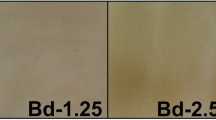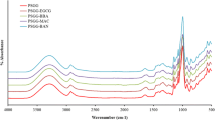Abstract
Active plasticized banana flour nanocomposite film (APBNF) incorporated with a different garlic essential oil (GO) content was formed using a solution casting to determine the film properties prior to the investigation of its effectiveness to preserve the roasted peanut quality. The GO concentration was positively correlated with the ultraviolet (UV) light barrier property and antioxidant activity indicating the ability to protect the packed food product from lipid oxidation. Additionally, incorporation of 1 mg/mL GO into APBNF showed the highest antioxidant activity and completely inhibited the growth of Aspergillus flavus. Fourier-transform infrared spectroscopy confirmed the functional group interactions between the film matrix and GO which act as an antioxidant and antimicrobial agent. Thus, APBNF incorporated with 1 mg/mL GO as an active packaging to preserve the quality of roasted peanuts was investigated comparing with a commercial plastic packaging of polyethylene terephthalate/low-density polyethylene (PET/LDPE; PET). The shelf life estimation of roasted peanuts packed in both packaging materials (APBNF and PET) based on the peroxide value (PV) was similar at high storage temperature (45 °C). Therefore, APBNF shows a multifunctional primary food packaging to maintain the quality of roasted peanuts or oily food products.


Similar content being viewed by others
References
Abdollahi, M., Rezaei, M., & Farzi, G. (2012). A novel active bionanocomposite film incorporating rosemary essential oil and nanoclay into chitosan. Journal of Food Engineering, 111(2), 343–350.
American Oil Chemists’ Society (AOCS). (1993). Method Cd 8-53: peroxide value acetic-chloroform method. In In official methods and recommended practices of the American Oil Chemists’ Society (4th ed.). USA: The American Oil Chemists’ Society (AOCS). Champaign, IL.
American Society of Testing and Materials (ASTM) International. (1997). Standard test methods for water vapor transmission of materials. Standard designations (pp. E96–E97). USA: ASTM International, West Conshohocken, PA.
American Society of Testing and Materials (ASTM) International. (2002). Standard test methods for tensile properties of thin plastic sheeting (D882-02). West Conshohocken, PA: ASTM International.
Association of Official Analytical Chemists (AOAC). (1995). Official methods of analysis (16th ed.). VA, USA: The Association Official Analytical Chemists Arlington.
Association of Official Analytical Chemists (AOAC). (2000). Method 934.01: loss on drying (moisture) at 95-100 °C for feeds. In W. Horwitz (Ed.), Official methods of analysis. 17 th edition. Association of Official Analysis Chemists Inc., Gaithersburg, MD, USA. Chapter (Vol. 4, p. 1).
Avila-Sosa, R., Palou, E., Munguia, M. T. J., Nevarez-Moorillon, G. V., Cruz, A. R. N., & Lopez-Malo, A. (2012). Antifungal activity by vapor contact of essential oils added to amaranth, chitosan, or starch edible films. International Journal of Food Microbiology, 153(1-2), 66–72.
Carpine, D., Dagostin, J. L. A., Bertan, L. C., & Mafra, M. R. (2015). Development and characterization of soy protein isolate emulsion-based edible films with added coconut oil for olive oil packaging: barrier, mechanical, and thermal properties. Food and Bioprocess Technology, 8(8), 1811–1823.
Du, W.-X., Olsen, C. W., Avena-Bustillos, R. J., McHugh, T. H., Levin, C. E., Mandrell, R., & Friedman, M. (2009). Antibacterial effects of allspice garlic, and oregano essential oils in tomato films determined by overlay and vapor-phase methods. Journal of Food Science, 74(7), M390–M397.
Haq, M. A., & Hasnain, A. (2012). Antioxidant containing gum cordia coating for control of peanut oxidation. Journal of Food Processing and Preservation, 38, 896–904.
Kanmani, P., & Rhim, J. W. (2014). Antimicrobial and physical-mechanical properties of agar-based films incorporated with grapefruit seed extract. Carbohydrate Polymers, 102, 708–716.
Kavoosi, G., Rahmatollahi, A., Mohammad Mahdi Dadfar, S., & Mohammadi, P. A. (2014). Effects of essential oil on the water binding capacity, physicomechanical properties, antioxidant and antibacterial activity of gelatin films. LWT - Food Science and Technology, 57(2), 556–561.
Kizil, R., Irudayaraj, J., & Seetharaman, K. (2002). Characterization of irradiated starches by using FT-Raman and FT-IR spectroscopy. Journal of Agricultural and Food Chemistry, 50(14), 3912–3918.
Labuza, T. P. (1982). Shelf life dating of food. Westport: Food and Nutrition Press Inc..
Lawrence, R., & Lawrence, K. (2011). Antioxidant activity of garlic essential oil (Allium sativum) grown in north Indian plains. Asian Pacific Journal of Tropical Biomedicine, 1(1), S51–S54.
Manso, S., Cacho-Nerin, F., Becerril, R., & Nerin, C. (2013). Combined analytical and microbiological tools to study the effect on Aspergillus flavus of cinnamon essential oil contained in food packaging. Food Control, 30(2), 370–378.
Mexis, S. F., & Kontominas, M. G. (2010). Effect of oxygen absorber, nitrogen flushing, packaging material oxygen transmission rate and storage conditions on quality retention of raw whole unpeeled almond kernel (Prunus dulcis). LWT - Food Science and Technology, 43(1), 1–11.
Mutegi, C. K., Ngugi, H. K., Hendriks, S. L., & Jones, R. B. (2009). Prevalence and factors associated with alflatoxin contamination of peanuts from Western Kenya. International Journal of Food Microbiology, 130(1), 27–34.
Orsuwan, A., & Sothornvit, R. (2015). Effect of miniemulsion cross-linking and ultrasonication on properties of banana starch. International Journal of Food Science and Technology, 50(2), 298–304.
Orsuwan, A., & Sothornvit, R. (2017a). Effect of banana and plasticizer types on mechanical, water barrier, and heat sealability of plasticized banana-based films. Journal of Food Processing and Preservation, 42(1). https://doi.org/10.1111/jfpp.13380.
Orsuwan, A., & Sothornvit, R. (2017b). Development and characterization of banana flour film incorporated with montmorillonite and banana starch nanoparticles. Carbohydrate Polymers, 174, 235–242.
Orsuwan, A., Shankar, S., Wang, L. F., Sothornvit, R., & Rhim, J. W. (2016). Preparation of antimicrobial agar/banana powder blend films reinforced with silver nanoparticles. Food Hydrocolloids, 60, 476–485.
Orsuwan, A., Shankar, S., Wang, L. F., Sothornvit, R., & Rhim, J. W. (2017). One-step preparation of banana powder/silver nanoparticles composite films. Journal of Food Science and Technology, 54(2), 497–506.
Otoni, C. G., Espitia, P. J. P., Avena-Bustillos, R. J., & McHugh, T. H. (2016). Trends in antimicrobial food packaging system: emitting sachets and absorbent pads. Food Research International, 83, 60–73.
Park, P., Je, J., & Kim, S. (2004). Free radical scavenging activities of differently deacetylated chitosans using an ESR spectrometer. Carbohydrate Polymers, 55(1), 17–22.
Pelissari, F. M., Andrade-Mahecha, M. M., Sobral, P. J. A., & Menegalli, F. C. (2013). Comparative study on the properties of flour and starch films of plantain bananas (Musa paradisiaca). Food Hydrocolloids, 30(2), 681–690.
Peyches-Bach, A., Moutounet, M., Peyron, S., & Chalier, P. (2009). Factors determining the transport coefficients of aroma compounds through polyethylene films. Journal of Food Engineering, 95(1), 45–53.
Pitak, N., & Rakshit, S. K. (2011). Physical and antimicrobial properties of banana flour/chitosan biodegradable and self-sealing films used for preserving fresh-cut vegetables. LWT-Food Science and Technology, 44(10), 2310–2315.
Pranoto, Y., Rakshit, S. K., & Salokhe, V. M. (2005). Enhancing antimicrobial activity of chitosan films by incorporating garlic oil, potassium sorbate and nisin. LWT-Food Science and Technology, 38(8), 859–865.
Pranoto, Y., Rakshit, S. K., & Salokhe, V. M. (2006). Physical and antibacterial properties of alginate-based edible film incorporated with garlic oil. Food Research International, 38, 267–272.
Rodriguez-Martin, M. L., Bello-Perez, L. A., Yee-Madeira, H., Ahong, Q., & Gonzalez-Soto, R. A. (2013). Nanocomposites of rice and banana flour blend with montmorillonite: partial characterization. Materials Science and Engineering C, 33(7), 3903–3908.
Rojas-Grau, M. A., Avena-Bustillos, R. J., Olsen, C., Friedman, M., Henika, P. R., & Martin-Belloso, O. (2007). Effects of plant essential oils and oil compounds on mechanical, barrier and antimicrobial properties of alginate-apple puree edible films. Journal of Food Engineering, 81(3), 634–641.
Sayanjali, S., Ghanbarzadeh, B., & Ghiassifar, S. (2011). Evaluation of antimicrobial and physical properties of edible film based on carboxymethyl cellulose containing potassium sorbate on some mycotoxigenic Aspergillus species in fresh pistachios. LWT - Food Science and Technology, 44(4), 1133–1138.
Solano, A. C. V., & de Gante, C. R. (2014). Development of biodegradable films based on blue corn flour with potential applications in food packaging. Effects of plasticizers on mechanical, thermal, and microstructural properties of flour films. Journal of Cereal Science, 60(1), 60–66.
Sothornvit, R., Olsen, C. W., McHugh, T. H. & Krochta, J. M. (2003). Formation conditions, water-vapor permeability, and solubility of compression-molded whey protein films. Journal of Food Science, 68(6), 1985–1989.
Sothornvit, R., & Pitak, N. (2007). Oxygen permeability and mechanical properties of banana films. Food Research International, 40(3), 365–370.
Sung, S.-Y., Sin, L. T., Tee, T.-T., Bee, S.-T., Rahmat, A. R., & Rahman, W. A. (2014). Control of bacteria growth on ready-to-eat beef loaves by antimicrobial plastic packaging incorporated with garlic oil. Food Control, 39, 214–221.
Teixeira, B., Marques, A., Pires, C., Ramos, C., Batista, I., Saraiva, J. A., & Nunes, M. L. (2014). Characterization of fish protein films incorporated with essential oils of clove, garlic and oreganum: physical, antioxidant and antibacterial properties. LWT-Food Science and Technology, 59(1), 533–539.
Thai community product standard (TCPS). (2006). Standard for fried peanut. TCPS 1147–2006 [in Thai].
Thakhiew, W., Devahastin, S., & Soponronnarit, S. (2013). Physical and mechanical properties of chitosan films as affected by drying methods and addition of antimicrobial agent. Journal of Food Engineering, 119(1), 140–149.
Wang, S., Adhikari, K., & Hung, Y. C. (2017). Effects of short storage on consumer acceptability and volatile compound profile of roasted peanuts. Food Packaging and Shelf Life, 13, 27–34.
Yin, M., & Tsao, S. (1999). Inhibitory effect of seven allium plants upon three Aspergillus species. International Journal of Food Microbiology, 49(1-2), 49–56.
Acknowledgements
The authors thank the Kasetsart University Research Development Institute (KURDI) and the Thailand Research Fund through the Royal Golden Jubilee Ph.D. Program (Grant No. PHD/0265/2552) for financial support throughout this research.
Author information
Authors and Affiliations
Corresponding author
Rights and permissions
About this article
Cite this article
Orsuwan, A., Sothornvit, R. Active Banana Flour Nanocomposite Films Incorporated with Garlic Essential Oil as Multifunctional Packaging Material for Food Application. Food Bioprocess Technol 11, 1199–1210 (2018). https://doi.org/10.1007/s11947-018-2089-2
Received:
Accepted:
Published:
Issue Date:
DOI: https://doi.org/10.1007/s11947-018-2089-2




